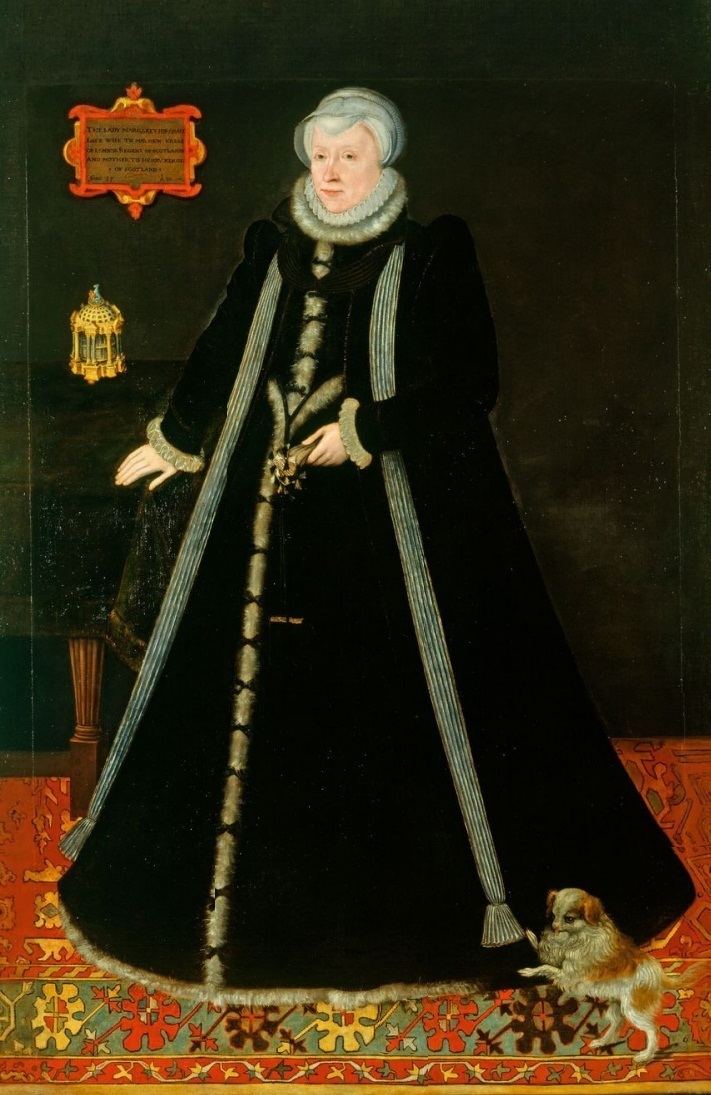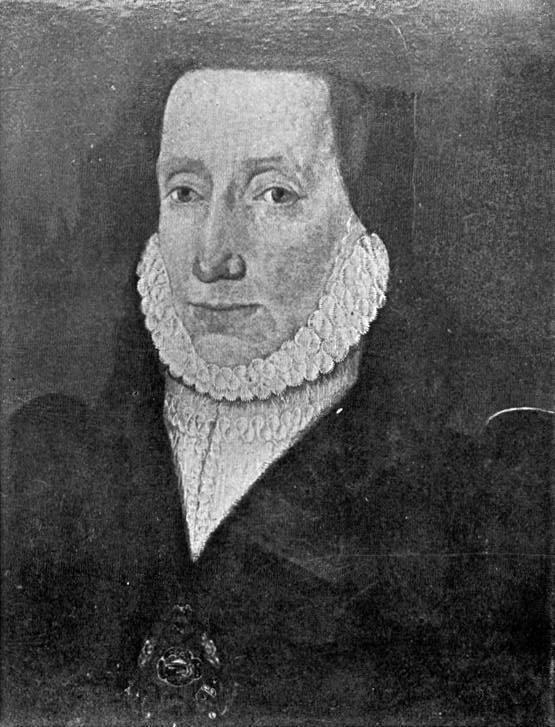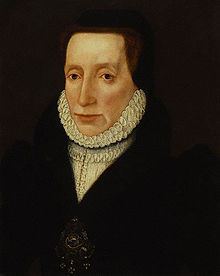Name Margaret Douglas | ||
 | ||
Born 8 October 1515 ( 1515-10-08 ) Died March 7, 1578, London Borough of Hackney, United Kingdom Children Henry Stuart, Lord Darnley, Charles Stuart, 1st Earl of Lennox Books The Devonshire Manuscript: A Women's Book of Courtly Poetry Parents Archibald Douglas, 6th Earl of Angus, Margaret Tudor Similar People Margaret Tudor, Archibald Douglas - 6th Earl o, Henry Stuart - Lord Darnley, Lady Arbella Stuart, James V of Scotland | ||
Margaret douglas
Margaret Douglas, Countess of Lennox (8 October 1515 – 7 March 1578) was the daughter of the Scottish queen dowager Margaret Tudor and her second husband Archibald Douglas, 6th Earl of Angus. In her youth she was high in the favour of her uncle, Henry VIII of England, but twice incurred the King's anger, first for her unauthorised engagement to Lord Thomas Howard, who died in the Tower of London in 1537 because of his misalliance with her, and again in 1540 for an affair with Thomas Howard's nephew Sir Charles Howard, the brother of Henry's wife Catherine Howard. On 6 July 1544, she married Matthew Stewart, 4th Earl of Lennox, one of Scotland's leading noblemen. Her son Henry Stuart, Lord Darnley, married Mary, Queen of Scots, and was the father of James VI and I.
Contents
- Margaret douglas
- Margaret douglas countess of lennox 1515 1578
- Early life
- Marriage and diplomacy
- Death and legacy
- Poetry
- In fiction
- References

Margaret douglas countess of lennox 1515 1578
Early life

Margaret was born at Harbottle Castle in Northumberland. Her mother had crossed the border from Scotland when her father was facing difficulties in Scotland. In October 1528, Angus was threatened by James V of Scotland and sent Margaret back over the River Tweed into England at Norham Castle. After a brief stay at Berwick Castle accompanied by her nurse or 'gentlewoman' Isobel Hoppar, Margaret joined the household of her godfather, Cardinal Wolsey. When Wolsey died in 1530, Lady Margaret was invited to the royal Palace of Beaulieu, where she resided in the household of Princess Mary. Because of her nearness to the English crown, Lady Margaret Douglas was brought up chiefly at the English court in close association with Mary, her first cousin, the future Queen Mary I, who remained her lifelong friend. At Christmastime at Greenwich Palace in 1530, 1531, and 1532, Henry VIII gave Margaret the generous sum of 10 marks (£6-13s–4d).

When Anne Boleyn's court was established, Margaret was appointed as a lady-in-waiting. There she met Anne Boleyn's uncle, Lord Thomas Howard, and they began their courtship. Thomas was a younger son of Thomas Howard, 2nd Duke of Norfolk, by his second marriage to Agnes Tilney. By the end of 1535 Thomas and Margaret had fallen in love and become secretly engaged.

King Henry turned against Anne Boleyn in May 1536. When in early July 1536 he learned of Margaret's engagement to Thomas Howard (Anne's uncle), he was furious. Henry had declared his daughters Mary and Elizabeth bastards, leaving Margaret very high in the line of succession; for her to contract an unauthorized marriage was politically outrageous, especially with the son of a powerful nobleman and near kin of the disgraced queen. Both Lord Thomas and Lady Margaret were committed to the Tower. On 18 July 1536, Parliament, by an Act of Attainder, condemned Thomas to death for attempting to 'interrupt ympedyte and lett the seid Succession of the Crowne'. The Act also forbade the marriage of any member of the King's family without his permission. Thomas was spared execution, but remained in the Tower even after Margaret broke off their relationship. He died there on 31 October 1537.

Margaret also fell ill in the Tower, and the King allowed her to move to Syon Abbey under the supervision of the abbess. She was released from imprisonment on 29 October 1537.
In 1539, Margaret and the Duchess of Richmond were appointed to greet Henry VIII's bride, Anne of Cleves, at Greenwich Palace, join her household, and convey her to the King. This would have been a great honour, but instead Henry chose to meet Anne at Rochester.
In 1540, Margaret was again in disgrace with the King when she had an affair with Lord Thomas Howard's half-nephew Sir Charles Howard. He was the son of Thomas' elder half-brother Lord Edmund Howard, and a brother of Henry VIII's fifth wife, Catherine Howard.
In 1543, Margaret was one of the few witnesses of King Henry's final marriage to Catherine Parr, Dowager Lady Latimer, at Hampton Court. Margaret became one of Queen Catherine's chief ladies. Catherine Parr and Margaret had known each other since they both had come to court in the 1520s.
Marriage and diplomacy
In 1544 Lady Margaret married a Scottish exile, Matthew Stewart, 4th Earl of Lennox (1516–1571), who later became regent of Scotland in 1570–1571. In June 1548, during the war of the Rough Wooing, Margaret's father, the Earl of Angus, wrote to her with the news that her half-brother George Douglas and others of the family had been captured at Dalkeith Palace. Angus hoped that she and Lennox could arrange that they were well treated as prisoners. Lennox forwarded the letter to Protector Somerset writing that Angus would have done better to ask others for help. Margaret wrote to her father from Wressle Castle in March 1549, complaining that he had avoided meeting Lennox. She asked him to seek an honourable peace through her marriage, "what a memorial it should be to you!"
During Queen Mary I's reign, Lady Lennox had rooms in Westminster Palace. In November 1553, the Queen told the ambassador Simon Renard that Lady Lennox was best suited to succeed her to the throne. Margaret was the chief mourner at Queen Mary's funeral in December 1558. On the accession of Queen Elizabeth I, Lady Lennox moved to Yorkshire, where her home at Temple Newsam became a centre for Roman Catholic intrigue. She succeeded in marrying her son, Henry Stuart, Lord Darnley, to his cousin Mary, Queen of Scots, thus uniting their claims to the English throne.
In 1566 she was sent to the Tower, but after the murder of Darnley in 1567 she was released. She denounced her daughter-in-law, but was eventually reconciled with her. Her husband assumed the government of Scotland as regent, but was assassinated in 1571. In 1574 she again aroused Elizabeth's anger by marrying her younger son, Charles, to Elizabeth Cavendish, the stepdaughter of the Earl of Shrewsbury. She was sent to the Tower, unlike the Countess of Shrewsbury, but was pardoned after her son's death in 1576.
Lady Lennox's diplomacy largely contributed to the future succession of her grandson, James VI of Scotland, to the English throne.
Death and legacy
After the death of her younger son, she helped care for his daughter, Lady Arbella. However, she did not outlive him by very long. A few days before her death, she dined with Robert Dudley, Earl of Leicester, and this led to rumours that she had been poisoned. There is no historical evidence to substantiate this.
Although she died in debt, she was given a grand funeral in Westminster Abbey, at the expense of Queen Elizabeth I. She was buried in the same grave as her son Charles in the south aisle of Henry VII's chapel in the Abbey. It has been said that her grandson erected the fine monument, but it was commissioned in October 1578 by her executor and former servant Thomas Fowler. Her recumbent effigy, made of alabaster, wears a French cap and ruff with a red fur-lined cloak, over a dress of blue and gold. On either side of the tomb chest are weepers of her four sons and four daughters.
The Lennox Jewel was most likely made for Lady Lennox in the 1570s although the date and occasion of its commission is the subject of some controversy. In 1842, the jewel was bought by her descendant, Queen Victoria. The locket, considered "one of the most important early jewels in the Royal Collection", is on display in the Holyrood Palace.
Poetry
Margaret Douglas is known for her poetry. Many of her works are written to her lover, Lord Thomas Howard, and are preserved in the Devonshire MS. Her close friends, Mary Shelton and the Duchess of Richmond, were the main contributors, as well as Henry Howard, Earl of Surrey and Thomas Wyatt.
In fiction
Margaret Douglas plays a significant role in the historical fiction series the Lymond Chronicles by Dorothy Dunnett.
She also appears in two of Philippa Gregory's Tudor court novels The Other Boleyn Girl and The Boleyn Inheritance.
The Lost Tudor Princess: A life of Margaret Douglas, Countess of Lennox is a biography by historian Alison Weir. It was published in 2015 by Jonathan Cape. Weir spoke about the book at the Wimbledon BookFest in October 2015.
